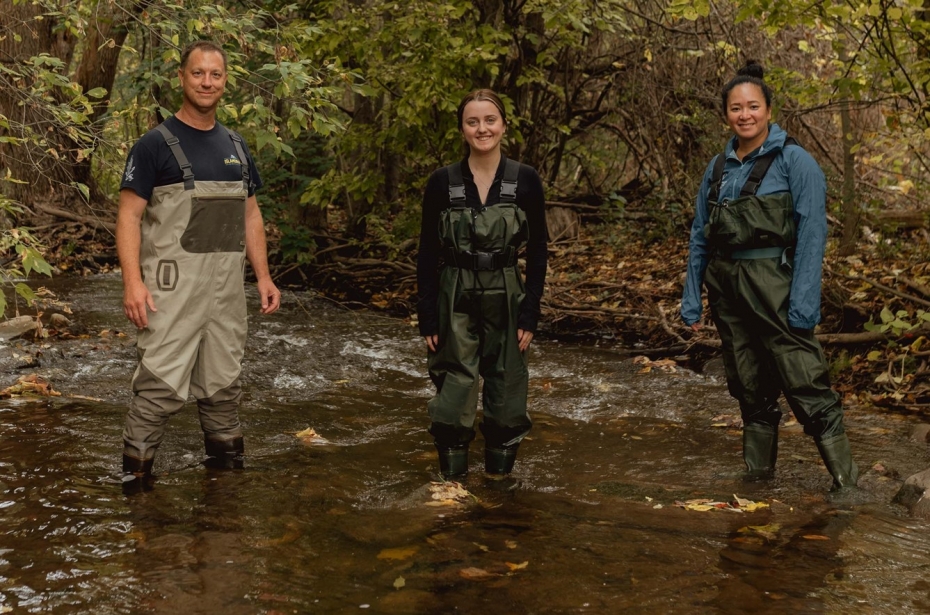 Trevor Pitcher, student Bri Curtis, and Catherine Febria stand in a stream in the Greater Toronto Area home to the redside dace. (Photo by Shayenna Nolan/University of Windsor)
Trevor Pitcher, student Bri Curtis, and Catherine Febria stand in a stream in the Greater Toronto Area home to the redside dace. (Photo by Shayenna Nolan/University of Windsor)
WINDSOR, Ont. — Freshwater biodiversity in the Great Lakes is facing a critical threat as several species of fish and mussels are disappearing at an alarming rate.
In response to this environmental crisis, a team of dedicated researchers from the University of Windsor, along with esteemed partners, have embarked on the transformative project Application and Assessment of Recovery Actions for Species at Risk Fishes and Mussels in the Lower Great Lakes.
The four-year initiative, generously funded with $850,000 from the Department of Fisheries and Oceans’ Canada Nature Fund for Aquatic Species at Risk, aims to develop a comprehensive understanding of habitat needs and threats, restore vital ecosystems, and pioneer captive breeding methods to save imperiled species.
Led by Trevor Pitcher, researcher and professor from the Department of Integrative Biology and the Great Lakes Institute for Environmental Research (GLIER), the project sheds light on the lesser-known crisis of "the invisible collapse" of freshwater biodiversity. Unlike its ocean counterpart, this silent emergency receives far less attention, making it all the more urgent to address.
"This project seeks to address the swift decline in freshwater biodiversity, particularly focusing on at-risk fish and mussels that have been insufficiently studied, especially in terms of habitat loss and captive breeding," says Dr. Pitcher.
"Our mission is to change this narrative and bring these species the attention and support they deserve."
The research consortium consists of other institutions, including McGill University, University of Toronto, St. Clair Region Conservation Authority, and Ausable-Bayfield Conservation Authority. The collaboration will tackle four key conservation aspects:
- Studying Habitat Needs and Restoring Critical Habitat: The team will meticulously study the habitat requirements of various species at risk and take necessary actions to restore and protect critical ecosystems within the Lower Great Lakes watershed.
- Understanding Stressors and Mitigation: The project will examine stressors such as road salt, thermal stress, turbidity, and hypoxia to better understand their impacts on endangered species. This knowledge will enable the formulation of effective mitigation strategies.
- Captive Breeding Methods for Endangered Species: The researchers will develop and implement captive breeding methods to safeguard endangered species from extinction, with a focus on the redside dace and spotted gar.
- Evaluating Previous Conservation Efforts: The team will assess the effectiveness of previous conservation endeavours, such as the translocations of at-risk mussels, to glean valuable insights for future conservation efforts.
Catherine Febria, the project collaborator and director of the Healthy Headwaters Lab, will lead the conservation efforts for freshwater mussel species kidneyshell, northern riffle shell, and snuffbox. These mussels face a severe risk of extinction in the Sydenham River watershed in southwestern Ontario.
"The Sydenham River boasts an unparalleled diversity of freshwater mussels, and their survival is intertwined with coordinated restoration efforts within the stream and across the entire watershed," explains Dr. Febria.
Collaborating closely with the St. Clair Region Conservation Authority and Fisheries and Oceans Canada, Dr. Febria's team will assess the distribution of mussel species at risk and their interconnectivity with habitats, fish, and other invertebrates. This in-depth research will pave the way for targeted conservation strategies to ensure the survival of these keystone species.
"By advancing research to inform conservation and restoration efforts, we can take significant strides towards reversing the decline of freshwater biodiversity. We are deeply grateful for the four-year funding that will empower us to accelerate conservation efforts based on our research findings," adds Febria.
The project's outcomes hold tremendous promise for the preservation of the Great Lakes' precious biodiversity. Through collaborative efforts and a commitment to protecting endangered species, the researchers aspire to leave a lasting legacy of thriving ecosystems and a brighter future for freshwater biodiversity.
